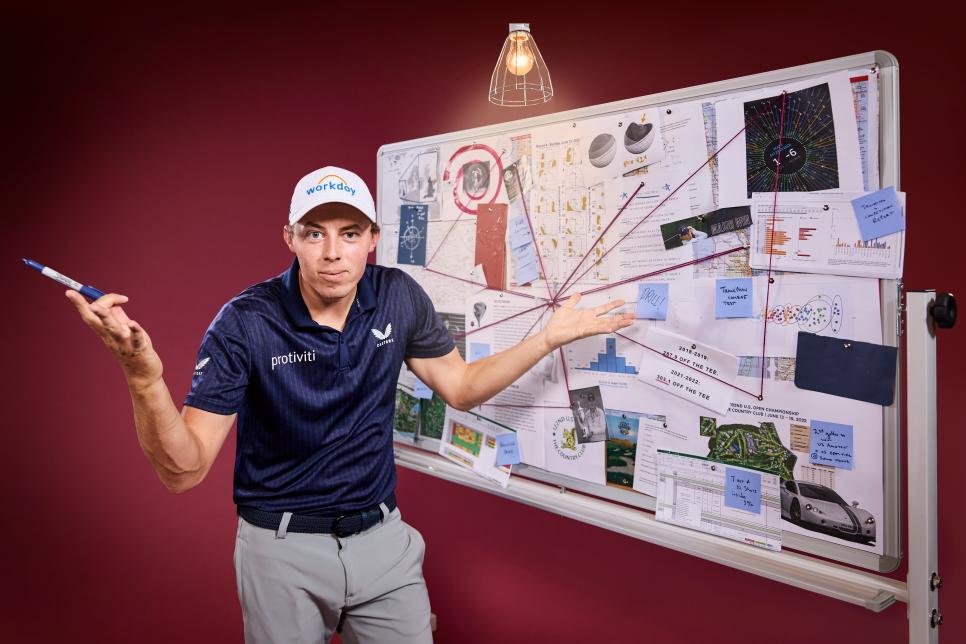

In the world of professional golf, every detail counts. Matt Fitzpatrick, one of the most promising golfers of his generation, has adopted a meticulous and analytical approach to optimize his performance. By using statistics intensively, Fitzpatrick has been able to transform his game and reach the highest levels in his career. This article explores how he integrates statistical data into his training and strategies, and how this approach has helped him become one of the best golfers in the world.
Although Matt Fitzpatrick won the US Amateur at 18 and was part of the Ryder Cup team before he turned 22, he knew that his game was not at the level of the best golfers in the world. After playing with players like Brooks Koepka and Justin Thomas, Fitzpatrick and his coach Mike Walker realized that he needed to make significant progress to compete with them.
Fitzpatrick is naturally analytical and uses this quality to maximize his performance. He consults a swing coach, a putting coach, a statistician, a physical trainer, a biomechanist, and a performance coach. Every shot he plays in competition is recorded and analyzed. He spends hours studying spreadsheets to find the smallest details to improve.
To analyze his swing, Fitzpatrick uses TrackMan, a radar that provides precise data on club speed, launch angle, ball spin, and trajectory. This information allows Fitzpatrick and his team of coaches to make fine adjustments to maximize the distance and accuracy of his shots.
.png)
Putting is a crucial aspect of Fitzpatrick’s game. He uses applications and analysis software to track his successful putt percentage at different distances and identify trends. To optimize his play on the greens, he even developed a coding system for his course notebooks, quickly noting relevant information without slowing down the game.
To increase his swing speed, Fitzpatrick consulted a biomechanist and used a device called The Stack System. This device helped him improve his speed and significantly increase his driving distance while maintaining his legendary accuracy.
Before each tournament, Fitzpatrick thoroughly analyzes the courses he will face. He uses historical data to understand trends on different holes and develop appropriate game strategies. For example, he may choose specific clubs for certain holes based on the conditions and obstacles present.
During tournaments, Fitzpatrick uses golf apps to obtain real-time information about his performance and that of his competitors. This data helps him make informed strategic decisions, such as club selection and target choice, which can make the difference between winning and losing.
Fitzpatrick’s analytical approach paid off in June when he won the US Open at the Country Club, joining Jack Nicklaus as the only men to have won both the US Amateur and the US Open on the same course. His outstanding performance throughout the tournament, particularly his impeccable approach on the greens and precise putting, demonstrates the effectiveness of his data-driven method.
Fitzpatrick is a model of continuous improvement. By using statistics to evaluate his performance and adjust his techniques, he manages to remain competitive against the world’s best players. His commitment to data analysis shows that even small adjustments can have a significant impact on results.
Matt Fitzpatrick’s use of statistics to optimize his performance is an excellent example of the successful integration of technology in professional golf. By meticulously analyzing his performance and using advanced tools to adjust his game, Fitzpatrick has been able to leverage data to constantly improve his playing level. His approach demonstrates that, in a sport where every shot counts, statistics can make all the difference.

Passionate golfer and co-founder of Teech Golf. My mission with Teech is to build technology that becomes a true companion in helping you improve your game.
Downloard Teech Golf on iOS/Android and get your free customized training plan with video by top coaches !
Download app